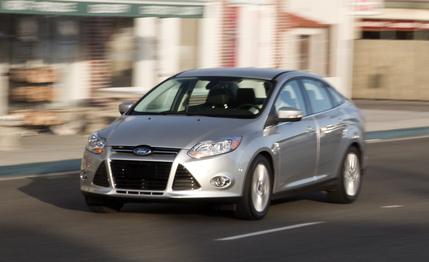
 Instrumented Test
Instrumented Test


Suavely shaped, swift on the run, and sophisticated in handling, technology, and amenities, the 2012 Ford Focus has a tough road ahead trying to turn a profit for its maker. Why?
The Focus’s task is almost impossible. It strives to be a “world car” when the world doesn’t really want the same car. The Focus is considered a medium-large vehicle for families and corporate middle managers in Europe. It is often the only car in a continental household, so buyers are willing to spend more. The average transaction price for a European Focus is the equivalent of about $28,000.
In America, you most often find a Focus parked at a sorority house or behind the bleachers at a high-school football game. Here, folks buy it because it’s small and relatively cheap and often add it to a household already flush with cars. Average transaction price: about 18 grand. The base 2012 Focus S starts at $16,995.
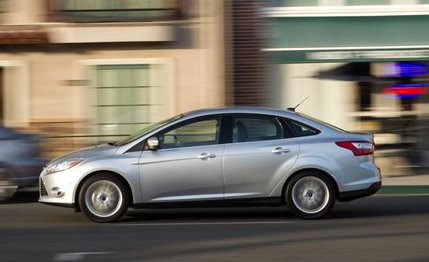

To resolve this disparity, Ford dumbed down the previous American Focus with cheaper materials and less content. But if the 2012 model is dumber than its European counterpart, engineers sure were smart about hiding it. Our Focus feels solid, unnaturally quiet, and stable at a rapid freeway clip or when cutting a sharp line along a coiling road. It was largely engineered and refined in Germany, and it feels like it.
Faking It Is Okay by Us
You’ll know the new Focus when it’s coming at you. The face has rally car written all over it. The gaping maw of radiator ducts is, when you look closely, almost entirely fake. It turns out that a 2.0-liter four-cylinder making 160 hp and 146 lb-ft, even if it is direct injected, doesn’t need three expansive radiator openings, so most of what looks like open space is blocked off. But that’s okay. The spirited look is cool and wears even better on the five-door hatchback. Spirited performance is also cool, and our fully loaded, 3045-pound SEL breezed past 60 mph in 7.6 seconds. For an economical car, that’s quick.
The 2012 Focus features Ford’s PowerShift twin-clutch six-speed automatic (standard on the SEL, $1095 on lower trim levels), but the technology might have been yanked out of the oven a few minutes early. It’s one of our few gripes with the car. Shifts can feel seamless if the driver is utterly unhurried, but they’re rather slow if there’s any attempt at upping the tempo. There were other problems, too. With 3000 miles on our test car, the clutches were already a little glazed and chattery, with vibrations working up the steering column when we rolled off under light throttle. And once, while maintaining about 35 mph on level ground, the SEL did a five-three downshift for no obvious reason. A glitch in an early production model, perhaps.
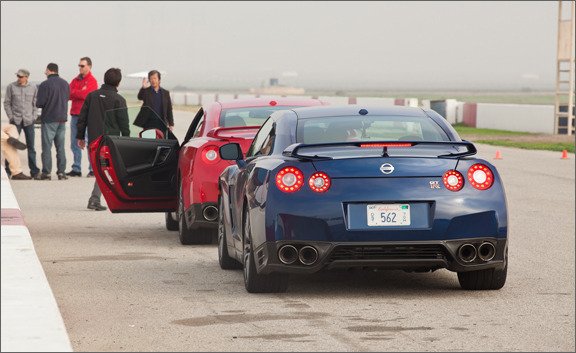

Generally, the transmission programming is biased for fuel economy (we’re still awaiting official EPA numbers, but we saw an average of 21 mpg in aggressive driving, which is well below even the expected city rating). It downshifts reluctantly, which makes the Focus seem a little lazy if you’re not standing on it all the time. Manual control is available via a rocker switch on the side of the shifter. It gets the job done but is about as satisfying as doing your taxes with a pocket calculator.
On a winding road, the little Ford is more enjoyable. Its handling is, well, focused. Although it feels tall from behind the wheel (it’s actually average for its class and slightly lower than the Chevy Cruze), it doesn’t sway excessively in corners, obeying commands from the expertly weighted and linear steering with lively responses and a reassuring tautness to the body motions. At 0.86 g, skidpad performance is about average for the class—how amazing is it that 0.86 g is average for compact sedans?—although it could be higher if the stability-control system were defeatable like the traction control is. “Average” also describes the Focus’s 173-foot stopping distance from 70 mph to 0.
Firm Ride, Daring Insides
The ride is definitely Euro-firm, especially compared with softies like the Toyota Corolla and the Cruze. But the cabin is isolated from wheel impacts, and the feeling is one of solidity—unlike in the new and significantly lighter Hyundai Elantra, which comparatively reverberates with shock waves on striking a chuckhole. Although we appreciate the Focus’s sturdy feel, those looking for a creamier ride will want to stay away from the 17-inch rims that come with the SEL’s Premium package.
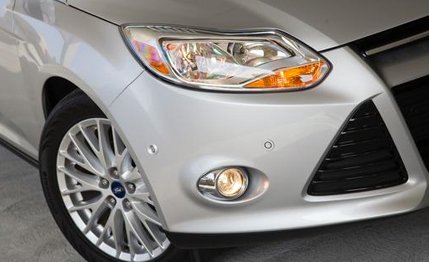

Head- and legroom are only decent for the class, especially in the back. Being a small car, the rear seats are snug with four adults aboard, and if the Mr. and Mrs. want to be comfy in back, they’d better put the kids up front—er, wait. Almost every one of the Focus’s competitors supplies greater rear-seat room, and at 13 cubic feet, the Focus’s trunk also lands on the small side of its segment.
But if it’s not the most spacious, it is easily one of the most daring cockpits in the class. The Focus’s interior styling mimics the Batcave, with flares of reflective black plastic and arcs of silver trim, and its mix of nice materials and first-rate design extends to the smallest details. Even the steering-wheel-mounted rocker switches operating the cruise control and infotainment functions are stylish.
High Tech and Low Intuition
Our other major complaint stemmed from the MyFord Touch system. Even on the top-shelf SEL, the setup, with its eight-inch center display, comes bundled with a Sony 10-speaker stereo for $1170 or in a $2755 package that includes leather seats. The capabilities of the system for providing entertainment and information are tremendous, but the busy screen is crowded with command prompts. Plumbing the depths of its many submenus takes eye time away from the road, and the touchscreen’s hot buttons aren’t always obvious—sometimes you press a free-floating word to jump to the next step, sometimes a color-shaded area, sometimes a defined button shape.
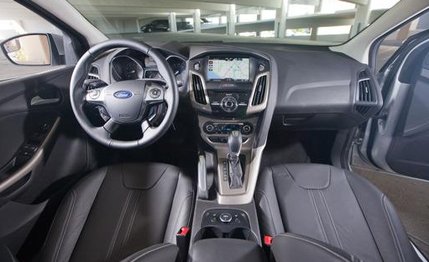

The iPad generation will definitely adapt to this more easily than some of us analog-era geezers, but we wish Ford had used some of the large, vacant area below the display for a few more physical buttons to jump to the different screens. Audi has made its complex MMI system far more accessible by adding a few plastic buttons. That company has not forgotten that the primary role of the driver is to drive, not to operate a recording studio and internet café.
Mechanically and technologically far more sophisticated than its predecessor, the 2012 Focus feels as if it were designed to be the only car in your household, not just basic transport for the kids. In fact, it’ll serve as both, and no matter who is behind the wheel, they’ll find the new Focus a thoroughly enjoyable small car.